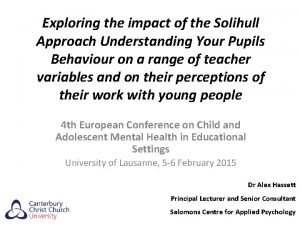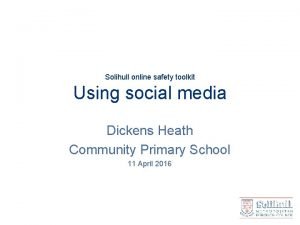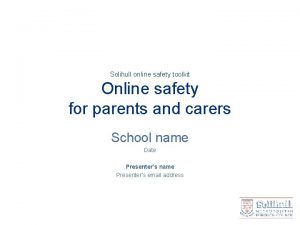Exploring the impact of the Solihull Approach Understanding



























































- Slides: 59

Exploring the impact of the Solihull Approach Understanding Your Pupils Behaviour on a range of teacher variables and on their perceptions of their work with young people 4 th European Conference on Child and Adolescent Mental Health in Educational Settings University of Lausanne, 5 -6 February 2015 Dr Alex Hassett Principal Lecturer and Senior Consultant Salomons Centre for Applied Psychology

Overview of the Talk • Background to the training and research • An overview of the Solihull Approach Understanding Your Pupil’s Behaviour training • The Research – Quantitative and Qualitative Results • Personal Reflections

Background to the study • Part of a consultancy and training and development programme based run by the Salomons Centre for Applied Psychology in Canterbury Christ Church University in Kent in collaboration with Solihull Approach • Funded by the Local Authority and Primary Care Trusts

Partnership with Solihull Approach • Solihull Approach – initially aimed at community health practitioners • Part of a broader workforce development programme in Kent • Trained over 2500 staff many of them pastoral staff from schools • Issue of how do they take this back to the school?

Role of schools in promoting emotional wellbeing

The Solihull Approach: Understanding Your Pupil’s Behaviour Based on the original Solihull Approach Framework

The Solihull Approach supporting relationships to improve outcomes Psychoanalytic theory (Bion) Child Development research (Brazelton) Behaviourism (Skinner) 7

Aims of the Solihull Approach Training • Provide the framework of the Solihull Approach model for understanding your pupil’s behaviour to support pupils to learn • Understand how relationships affect behaviour • Understand the importance of relationships for brain development • Provide a ‘framework for thinking’ when learning about behavioural techniques 8

Aims of the Solihull Approach Training • Enable practitioners to apply their knowledge of behavioural techniques more effectively through understanding their pupils’ behaviour • This training does not aim to teach behaviour management techniques. There are many other trainings and resources available for this. This training aims to put behaviour management techniques into a framework that will increase their effectiveness 9

Why the Solihull Approach maybe useful • Helps with professional responsibilities and stress • Provides a framework to help 'contain' their role as a professional worker • Containment from colleagues may be especially helpful when working with particularly challenging or difficult situations • Provides a shared language • Helps decision making • Supports the safeguarding process – capacity to think and calm communication 10

The relational context of behaviour management • Emphasises the relationship between educator and pupil and the relational context of effective behaviour management

Brains develop in the context of a relationship

The Solihull Approach THEORETICAL MODEL

Containment Bion – psychoanalyst Understanding emotional communication Helping to process it Emotion is experienced as tolerable and manageable • Restores capacity to think • •

Containment for Learning Thinking about the impact of emotions on our capacity to concentrate, think and learn.

Containment in Schools • Effective teaching and learning take place in a containing environment • Teachers need to feel contained enough to teach and pupils contained enough to learn

Containment and the brain • Parallel process

The Solihull Approach THEORETICAL MODEL

Reciprocity • • Brazelton – Child Development Research Attunement Two-way interaction Dance of reciprocity – initiation, regulation and termination

Reciprocity In The School • Rhythm of building up and calming down • Link to containment – are children in the best state for thinking, is their arousal system lower, are they calmer and ready to learn? • Reciprocity in lessoning planning – building up to an activity or piece of learning and then winding down

Reciprocity • Look away • Chase and Dodge • Rupture and Repair • Good enough parenting

The Solihull Approach THEORETICAL MODEL

The relational context of behaviour management • Links the role of containment and reciprocity to pupils’ behaviour • Links the role containment and reciprocity in enabling learning • Thinking not only about the relationship/ interaction between child and educator but also within the broader school context

What is meant by Behaviour for Learning? • the containment of children’s emotions/ anxieties so that the child can concentrate and think • reciprocity between the teacher and child so that the child is regulated enough to take in and process information • optimal brain development so that the child has neural pathways to both self regulate and to learn © Solihull Approach 24

The Research What impact does the Solihull Approach Understanding Your Pupil’s Behaviour on teacher levels of stress, anxiety, mood, sense of teacher efficacy, self-esteem at 6 months after the training

Rationale for Measuring Teacher Outcomes Hypothesis • It is argued that by understanding and using the approach teachers will feel more contained themselves and will be in a better position to be attuned to their pupils’, the parents’ and colleagues’ behaviour • In doing this they will be less stressed and feel more able to do their jobs

Methodology • The study focused on a group of teachers from 2 primary schools in Kent. One the experimental group received the training the other the control (this group received the training after the research if they are interested). • In order to assess the impact of the training a pre -test follow-up at 6 months design was be used. • Interviews were conducted with teachers from the school receiving the training

Measures • Stress, burnout and compassion saitifaction Professional Quality of Life Scale (PROQOL) (Stamm, 2009). • The Robson Self Concept Questionnaire (Robson, 1989) • Teacher Efficacy Scale - Guskey, T. R. , & Passaro, P. D. (1994) • The Generalized Anxiety Disorder Assessment Version 7 (GAD 7; Spitzer, Kroenke, Williams, et al; 2006) • The Patient Health Questionnaire (PHQ-9, Kroenke, Spitzer, Williams; 2001)

The participants School 1: Received the training • 3 twilight session • 26 staff including teachers, support staff and administrators • Had 6 monthly follow up sessions with approximately 10 staff members. School 2: Control • 30 staff including teachers, support staff and administrators

Quantitative Results 30

Findings • School A – Six month after receiving the training showed a statistically significant: – increase in satisfaction with their helping role – decrease in feeling burnt out/stressed – increase in self-esteem – increase in teacher efficacy scores • School B – which received no training only showed an improvement in teacher efficacy over the period.

Qualitative Data Collection • 7 staff were interviewed from School 1 • A semi-structured interview asking about their views on the training, whethere had been any impact, what they felt had facilitated and hindered the process • A thematic analysis of the interviews was undertaken

Qualitative Results 33

Teachers’ Views on the Training Overall teachers found the following useful: • Offered a framework that underpinned all aspects of the work they do • Focus on the relationships not only with pupils but teachers and support staff and parents as well • Focus on well-being and its link with learning

Teachers’ Views on the Training All the interviewees felt that the overarching framework had provided theory and ‘scientific’ back-up for what they were doing. For example: • Children who had experienced trauma, fidgeting made sense not as naughtiness but as an attempt to self-regulate • Having time to share your struggles with colleagues now made sense in terms of containment

Teacher Views on the Impact Staff reported that it had impacted on their interactions with: • The children, • The parents and • Other staff members

Impact on Interactions with Children Offered a different perspective on behaviour • Taking the child's perspective • Understanding where certain behaviours may be coming from • Understanding theory behind why children may behave the way they do

Changed perspective on behaviour Move away from simple solutions Example: “Firstly I didn’t realise how big behaviour was, which is quite strange I’ve been teaching now for a million years anyway … I’ve been looking for like a quick fix for a particular child and then I realised that it needed to be bigger than that”

Changed perspective on behaviour Move away from labelling to understanding Example: “It’s changed my views of behaviour. So sometimes when I see, what I would ascribe to not doing as they were told, you know, fidgeting, or so-and-so’s definitely got ADHD, now I’m looking more perhaps, thinking why are they behaving this way, what’s the behaviour showing me apart from the surface impression. So I’m perhaps more lenient? I don’t know, I try to be more understanding perhaps”.

Taking the child's perceptive Rupture and repair = falling out and building bridges • “the whole dance of when you’re falling out and building bridges, that, those were the two bits that really I think about and could use. And I can sort of see it in children now when they’re trying to, like if I’ve been cross with them for doing something I can see now that they’re trying to, when they come up and say ‘Oh can I just show you this Miss X’ and I know it’s because they’re trying to build bridges again and now that I’m more aware of it and of why I sort of tend to maybe give them more time with that or make sure that I’ve actually responded rather than thinking that oo hang on I’ve just got to do this, I try and make a point of saying ‘yeah, you know, that’s great, well done I’m really pleased’ so that they know that everything’s fine whereas I didn’t really know to think about that before I just thought ‘oh how lovely’”.

Taking the child's perceptive Chase and Dodge Examples: Realising that making children look at you when you’re talking to them is not always useful – particularly if they are already stressed (or if you’re stressed out)

Using containment with behaviour management • There’s somebody in my class who joined quite recently, quite challenging behaviour. And as well as very firm boundaries I have used the reflecting back to him how he is feeling and erm, yeah it’s worked. • In terms of what you’ve noticed about the response to that? • When I say it’s worked, it’s enabled him to calm down and be more reflective himself to work out a bit more in other words to think he’s actually said ‘it’s helped me to think twice’ so I think that’s got to be rather good. • Yeah it’s also really good that HE could say it’s helped me think twice’ • Yes, I know he doesn’t always think twice but at least he realises that you can think twice, you know. He’s a very intelligent child, but erm he needs to take charge of his emotions rather than just let them run riot

Impact on themselves • Feeling less stressed • Own well-being • Confidence in their ability • Several teacher mentioned that having a different perspective and support from other staff has made them feel more relaxed

Containing Teachers Anxieties Lead to them Being More Reciprocal Talking about her difficulties managing a young boys behaviour as she knew he had been abused and felt that as she was not a mental health specialist she may do something that would be damaging to him and so found it hard to respond to him a teacher said:

Containing Teachers Anxieties Lead to them Being More Reciprocal “I sort of could use that with him and that made me again more relaxed with him so that I could sort of, erm because I was worried I was doing the wrong thing … having someone’s input in that way helps me think that I’m not going to do him damage by acting the wrong way. Because particularly because he’s got certain needs, so generally I don’t worry about that so much but when there’s certain children that you know certain things have happened in the past, it’s definitely more of a worry that you’re going to do more damage so having someone to then talk about things you just get the reassurance that actually it’s ok and you know you can adapt things and everything. So in that way, I’ve definitely used that as well. ”

Impact on Interactions with Parents • Containing parents feelings • Understanding their perspective

Impact on Interactions with Other Staff Members All the staff reported that staff relationships / interactions had changed: • More sharing and openness • A willingness to show vulnerability • Not reacting so fast to things • People being more amenable to discussions with other staff Felt the SA offered a structured way to think about their interactions

Led to changes in support structures • • • Morning briefings Planning, Preparation and Assessment time Phase Group Time Staff Meeting Time Focus Group All focused on joint working and sharing information about pupils particularly those with challenging behaviour

Limitations • Sample size • Matching of schools • Could not exclude other factors • However still showing promising signs

Challenges Around Measuring Outcomes for Preventative Interventions and Training Initiatives • What do we measure? • How do we know it was due to the training? • Challenge around measuring outcomes on children from training delivered to practitioners • Long-term studies needed

Tentative Conclusions • Both the quantitative and qualitative data suggest that the Solihull Approach Understanding Your Pupils’ Behaviour has had a positive impact on teachers • The quantitative data suggests there has been an impact on teachers interactions with their pupils, the parents and colleagues and it has led to wider school changes.

Extended Due to Interest • Trained the control school and 2 other schools offered to participate based on the response from the 2 initial schools

Support session • All schools were offered 6 follow up support sessions • Only School 1 took up the six sessions.

Data from the other schools • School B: increase in compassion satisfaction on Pro. Qol • School C: no significant difference • School D: no significant difference • Suggests that the support sessions are a key to embedding the ideas from the framework. However this needs further research.

Challenges • Not all staff taking up the approach • Time and funding • Support sessions take up and how they are structured • Parents not having the same information

Facilitators • Trained as a whole staff – importance of including support staff and admin • Working across the years • Support in place

Learning from the experience • Not being a teacher • Making a relational model fit in a classroom / school environment • Using whole school, classroom and individual examples • Size of the group • Composition of the group matters

Some teacher’s views that were challenging • Not having time – how much time spent on not planning around disruptive behaviour • You are making excuses for poor behaviour / poor parenting • It is not possible to use the approach when dealing with the range of needs in a class • It’s not fair, we need to treat all children equally • Children getting one up on you

alex. hassett@canterbury. ac. uk
 Solihull approach triangle
Solihull approach triangle Solihull approach triangle
Solihull approach triangle Solihull approach model
Solihull approach model Tyber solihull sixth form
Tyber solihull sixth form Social media solihull
Social media solihull Live happy live healthy
Live happy live healthy Solihull alternative provision academy
Solihull alternative provision academy Understanding ekgs a practical approach
Understanding ekgs a practical approach Critics who view culture as a map
Critics who view culture as a map Cognitive approach vs behavioral approach
Cognitive approach vs behavioral approach Traditional approach of development
Traditional approach of development What is research approach
What is research approach Waterfall approach marketing example
Waterfall approach marketing example Deep learning approach and surface learning approach
Deep learning approach and surface learning approach Approach approach conflict
Approach approach conflict Virtual circuit network and datagram network
Virtual circuit network and datagram network Cognitive approach vs behavioral approach
Cognitive approach vs behavioral approach Bảng số nguyên tố lớn hơn 1000
Bảng số nguyên tố lớn hơn 1000 đặc điểm cơ thể của người tối cổ
đặc điểm cơ thể của người tối cổ Mật thư tọa độ 5x5
Mật thư tọa độ 5x5 Các châu lục và đại dương trên thế giới
Các châu lục và đại dương trên thế giới Chụp tư thế worms-breton
Chụp tư thế worms-breton ưu thế lai là gì
ưu thế lai là gì Thẻ vin
Thẻ vin Tư thế ngồi viết
Tư thế ngồi viết Cái miệng nó xinh thế chỉ nói điều hay thôi
Cái miệng nó xinh thế chỉ nói điều hay thôi Các châu lục và đại dương trên thế giới
Các châu lục và đại dương trên thế giới Bổ thể
Bổ thể Từ ngữ thể hiện lòng nhân hậu
Từ ngữ thể hiện lòng nhân hậu Tư thế ngồi viết
Tư thế ngồi viết V cc cc
V cc cc Thể thơ truyền thống
Thể thơ truyền thống Bài hát chúa yêu trần thế alleluia
Bài hát chúa yêu trần thế alleluia Khi nào hổ con có thể sống độc lập
Khi nào hổ con có thể sống độc lập đại từ thay thế
đại từ thay thế Diễn thế sinh thái là
Diễn thế sinh thái là Vẽ hình chiếu vuông góc của vật thể sau
Vẽ hình chiếu vuông góc của vật thể sau Phép trừ bù
Phép trừ bù Công thức tính độ biến thiên đông lượng
Công thức tính độ biến thiên đông lượng Thế nào là mạng điện lắp đặt kiểu nổi
Thế nào là mạng điện lắp đặt kiểu nổi Tỉ lệ cơ thể trẻ em
Tỉ lệ cơ thể trẻ em Lời thề hippocrates
Lời thề hippocrates Vẽ hình chiếu đứng bằng cạnh của vật thể
Vẽ hình chiếu đứng bằng cạnh của vật thể Quá trình desamine hóa có thể tạo ra
Quá trình desamine hóa có thể tạo ra Các môn thể thao bắt đầu bằng tiếng đua
Các môn thể thao bắt đầu bằng tiếng đua Hình ảnh bộ gõ cơ thể búng tay
Hình ảnh bộ gõ cơ thể búng tay Khi nào hổ mẹ dạy hổ con săn mồi
Khi nào hổ mẹ dạy hổ con săn mồi Các loại đột biến cấu trúc nhiễm sắc thể
Các loại đột biến cấu trúc nhiễm sắc thể Biện pháp chống mỏi cơ
Biện pháp chống mỏi cơ độ dài liên kết
độ dài liên kết Trời xanh đây là của chúng ta thể thơ
Trời xanh đây là của chúng ta thể thơ Voi kéo gỗ như thế nào
Voi kéo gỗ như thế nào Thiếu nhi thế giới liên hoan
Thiếu nhi thế giới liên hoan điện thế nghỉ
điện thế nghỉ Fecboak
Fecboak Một số thể thơ truyền thống
Một số thể thơ truyền thống Thế nào là hệ số cao nhất
Thế nào là hệ số cao nhất Lp html
Lp html Hệ hô hấp
Hệ hô hấp Performance lawn equipment case study
Performance lawn equipment case study














































































